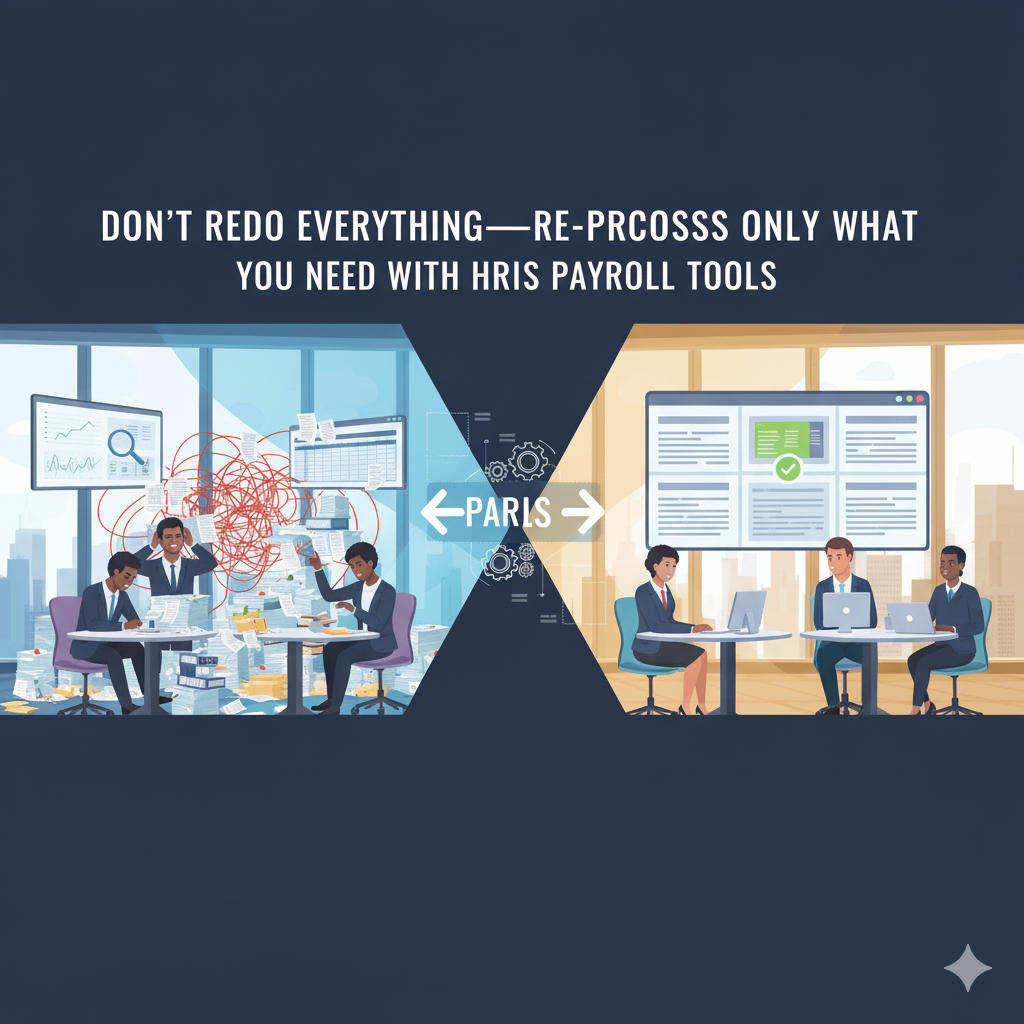Payroll errors happen — whether it’s a late attendance adjustment, missed overtime entry, or a new allowance update. Traditionally, even a small correction required re-running the entire payroll process for all employees, wasting time and increasing the risk of new errors.
Fortunately, modern Human Resource Information Systems (HRIS) now allow HR professionals to re-process payroll selectively — adjusting only what’s necessary without disturbing the rest of the data.
This is a game-changer for payroll accuracy, efficiency, and compliance.
What Is Payroll Re-Processing in HRIS?
Payroll re-processing refers to the recalculation of salary components after payroll has already been run — usually to correct data errors or update late changes such as:
- Attendance or timesheet corrections
- Adjusted leave records
- Retroactive salary changes or deductions
- New hires or terminations added after the initial run
With an advanced HRIS payroll module, you can now re-process only selected employees instead of redoing the entire batch. This targeted recalculation saves time, preserves accuracy, and minimizes disruption.
How HRIS Simplifies Payroll Re-Processing
Modern HRIS systems are designed to handle payroll adjustments intelligently. Here’s how they make selective re-processing smooth and efficient:
- Employee-Specific Payroll Runs
Instead of regenerating all employee payroll data, HRIS lets HR users filter and select specific employees for re-processing. This feature isolates the affected records without affecting finalized payroll data. - Automated Adjustment Calculations
Once changes are entered (like an overtime correction), the HRIS automatically recalculates only the impacted components — gross pay, deductions, taxes, and benefits — ensuring compliance and precision. - Real-Time Data Integration
HRIS systems integrate time tracking, attendance, and benefits data. Any approved changes in these modules automatically reflect in payroll during re-processing. - Clear Audit Trails
Every re-processing action is logged — including who made the adjustment, what data was changed, and when. This ensures full transparency for auditing and compliance purposes. - Secure Access Control
Only authorized users can trigger payroll re-processing, protecting sensitive payroll data from accidental or unauthorized changes.
Benefits of Selective Payroll Re-Processing in HRIS
Adopting this feature brings significant advantages for both HR teams and management:
- Time and Cost Efficiency
Re-processing only selected employees saves hours of manual recalculation and validation — boosting overall HR productivity. - Reduced Risk of Payroll Errors
By focusing on affected employees only, HRIS minimizes the chance of introducing new errors while fixing existing ones. - Improved Accuracy and Compliance
Automated recalculations ensure that statutory deductions, taxes, and contributions remain accurate after corrections. - Seamless Employee Experience
Employees receive corrected pay on time, reducing complaints and improving trust in HR processes. - Easy Reporting and Verification
Built-in HRIS reporting tools let HR teams generate comparison reports between original and re-processed payrolls for easy verification.
Example Scenario: Fixing an Overtime Error
Imagine you’ve already processed payroll for 250 employees, but later find that 10 employees’ overtime hours weren’t included.
With an HRIS payroll re-processing tool, you can:
- Select those 10 employees.
- Update their overtime entries.
- Re-run payroll for only those individuals.
- Generate updated payslips and post corrections instantly.
No need to touch the other 240 employees’ payroll — saving hours of unnecessary work and eliminating potential new mistakes.
Best Practices for Payroll Re-Processing in HRIS
To make the most of your HRIS tools, follow these best practices:
✅ Set clear approval workflows before re-processing any employee payroll.
✅ Lock finalized payroll periods to prevent accidental changes.
✅ Run simulations first to preview results before posting.
✅ Communicate transparently with employees about corrections and updates.
✅ Regularly audit HRIS configurations to ensure accurate rule setups for deductions, taxes, and allowances.
Key Takeaway
In today’s digital workplace, HR and payroll teams can’t afford to waste time redoing entire payroll cycles over minor corrections.
By using HRIS payroll re-processing tools, companies can quickly and accurately fix payroll issues for selected employees only, ensuring accuracy, compliance, and employee satisfaction — without redoing everything from scratch.
Final Thoughts
Payroll accuracy builds employee trust and operational credibility. With HRIS automation, fixing payroll errors no longer means starting over — it’s simply a matter of re-processing what’s necessary.
If your organization still handles payroll manually, it’s time to explore an HRIS platform that gives you full control, flexibility, and accuracy in every pay cycle.
👉 Experience the smarter way to manage payroll — explore HRIS re-processing tools today!

